| |||
| Capital (and largest city) |
Beijing | ||
| Other cities | Shanghai, Shenzen, Fuijan, Nanjing, Chongqing, Qingdao, Ningbo, Shenyang (Mukden), Guanzhou | ||
| Language official |
Mandarin Chinese | ||
| others | Cantonese, Fukien, Russian, Xibe, Manchu, Korean | ||
| Religion main |
Buddhism (de facto) | ||
| others | Taoism, Confucianism, Christianity, Islam | ||
| Ethnic Groups main |
Chinese | ||
| others | Manchu, Mongolian, Korean, Xibe, Uyghur, Russian, Vietnamese, Laotian, Burmese | ||
| Demonym | Chinese | ||
| Government | Democratic federal constitutional republic | ||
| President | |||
| Independence | from People's Republic of China | ||
| declared | 1990 | ||
| recognized | 1991 | ||
The Chinese Federated Union (CFU), commonly referred as China, New China, or Democratic China is a democratic state in East Asia, formed after the People's Republic of China fragmented following the result of the Second Chinese Civil War. The country covers much of the former PRC, except for Xinjiang, Tibet, and Taiwan. The country is the most populated and is also one of the potential superpowers of the world.
History
Second Chinese Civil War
The People's Republic of China entered World War III on the side of the Soviet Union and the Communist Bloc. Subsequently, China declared war on the United States, the United Kingdom, NATO, and the allied states. Citizens were told the war was necessary and winnable against the capitalists. Seeing the United States busy in Europe, The People's Liberation Army then launched attacks on Hong Kong, Macau, Taiwan, India, South Korea, Burma, Nepal, Japan, the Philippines, Guam and the Northern Mariana Islands. They also agreed to send reinforcements to Soviet troops in Alaska and British Columbia. However, victory was not achievable as the Allies were able to evict the Soviets out of the West Coast. In Japan, the Chinese only got as far as Hokkaido (with Soviet backing) and were driven off in Okinawa. The same situation happened in the Philippines were the limited Chinese invasion force never made it to Manila. Additionally, ships of the People's Liberation Army were sunk on a daily basis by submarines from the US, UK, Australia, and Japan.
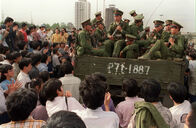
PLA soldiers from the 38th Army defects to the pro-democracy rebels.
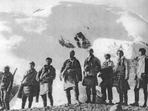
Tibetan insurgents moments before attacking the loyalist PLA.
The MI6 and the CIA, through Special Activities Division, began sending arms to secessionists in Xinjiang and Tibet to distract the PLA. SAD and MI6 agents were also present in aiding these secessionists in combat; subsequently they were also sent to Macau, Hong Kong, and Taiwan. The unrest in Xinjiang and Tibet brought the PLA's attention there. As this happened, the US and the West announced China's defeat in North America and the Pacific in hopes of inciting anger among the local populace. Majority of the citizens, still angry at the communist party over the Tiananmen Square Massacre and the fact they were lied about the progress of the war, immediately took up arms against the regime. The Central Military Commission ordered the troops that just came from North America and the Pacific to quell these riots. It would be how many months later when the war weary PLA began to question the war. Already tired of fighting, majority of the PLA defected to the rebels. There were still troops loyal to the CPC. Shots from both sides erupted, as the Second Chinese Civil War began.
The rebels troops first released former General Secretary Zhao Ziyang from house arrest. Zhao had been fired from his post during the Tiananmen Square protests for openly hearing the student's protests. After his arrest, Premier Li Peng ousted Deng Xiaoping from the CMC and ordered the crackdown on the student protestors. The rebels subsequently elected Zhao as the first president of the new democratic China.
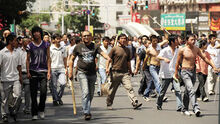
Chinese citizens, including Tibetans and Uyghurs, armed with improvised melee weapons fight back against the CPC forces in Chongqing.
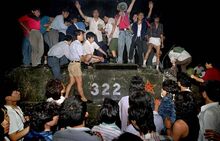
Chinese citizens celebrate the downfall of the communist regime in Beijing.
The Chinese mainland was then gripped in chaos as rebels and government forces fought each other. The rebels of different beliefs and motives united as one fighting force, which made the loyalist PLA forces scattered throughout. However, the unity showed by the rebels would encourage more ordinary Chinese citizens to rise up against the communist party. Soon, the loyalist forces would end up getting outnumbered as more citizens joined the rebels' cause. This also encouraged some of the loyalist forces to defect to rebels - dealing a huge blow to the loyalist PLA regiments. One by one, cities started to fall. Upon the fall of Lhasa and Urumqi to the rebel forces, Tibet and Xinjiang declared de facto independence - with the latter known as East Turkistan. On the Chinese coast, Shanghai and Ningbo were captured and naval bases put to use. Meanwhile, months into the war, the Commonwealth realm liberated Hong Kong and Macau from the loyalist Chinese. The Western Allies decided to let the rebels defeat the CPC forces, but nonetheless showed their support to their cause, supplied them with weapons and aid, and recognizing the states of Tibet and East Turkistan. By August 1990, the rebels had surrounded Beijing and were slowly entering the city. Fierce street and house-to-house fighting followed. By the second week of September 1990, the CPC leaders prepared to escape Beijing to a secret leadership bunker in the Kunlun Mountains - which was built to withstand a nuclear war with both the Soviets and the Americans. However, the escape was botched as the rebels captured the Zhongnanhai. Li Peng and the other hardliners were captured by rebel forces and made into prisoners of war.
Reconstruction
Zhao Ziyang, first President of the new China.
President Zhao placed the country under temporary martial law in order to restore order. Unlike last time in 1989, this was received warmly by the Chinese people. Both sides were ordered to lay down their arms to the transition of peace. Meanwhile, Zhao met with the Dalai Lama of Tibet and the leader of East Turkistan, promising to them that the new China will recognized Tibetan and Uyghur independence. Surprisingly, he also met with Taiwanese President Lee Teng Hui where he apologized for the PRC's damaged and grief caused to Taiwan; additionally Zhao shocked the world when he would recognize Taiwan as an independent state by October 1, 1991 - the same for Tibet and East Turkistan. Foreign observers took note of this date since the first of October is the day the former People's Republic was proclaimed in the Chinese mainland.
The New China emerges
The Chinese Federated Union was recognized by the international community as the successor of Communist China in August 1991. Majority of the worlds' nations proceeded to establish diplomatic ties with the new China. As promised, on October 1, 1991, the world saw the independence of Tibet, East Turkistan, and Taiwan - three sovereign states that finally gained their independence. Inspired by the independence of these states, Manchurians held a referendum in 1995 to seek autonomy or independence. Autonomy was chosen as an experiment on self-governing affairs, and by 1996, the province Manchuria became known as the Manchuria Autonomous Territory.
In the economic aspects, Western companies found the new China as wise place for investment. From the mid-1990s to the beginning of the 21st century, Western products and business were booming in China, such as McDonalds, KFC, Apple, Adidas, and Nike. In the early 2000s, China's economy was growing and was predicted to surpass the United States by the 2010s.

Hong Kong in 2007, 10 years after the handover.
In 1997, the United Kingdom returned the sovereignty of Hong Kong to the Chinese Federated Union. Despite the colony being invaded by the PRC, the new democratic government convinced the UK to hold talks with the CFU. The CFU promised to withstand the agreement with the British in 1984, however, the "One Country, Two Systems" agreement is only in name since the new China is a democracy. On New Year's Day in 2000, Portugal handed over the sovereignty of Macau to the CFU, which included a fanfare New Year's celebration during the handover ceremony.
In April 2005, President Zhao past away from stroke. The entire country and the international commuity mourned for Zhao who brought democracy to China and independence to Tibet, East Turkistan, and Taiwan. His Vice President assumed Presidency. The same year on August 9, Japan formally apologized for its war crimes in World War II. This coincided with the 60th anniversary of the Empire of Japan's defeat, which was symbolic, and thus it warmed the relations with China and the united Korea.
By 2012, China and the United States economies were tied up with each other. By 2014, China had caught up briefly with the U.S. before being caught by the U.S. again in 2015. Economists see this "economic tug-of-war" or "leapfrogging" as positive way for both countries to push greater economic ties.
Politics
The Chinese Federated Union's form of government is a federal presidential constitutional republic, similar to the governments of the United States and Russia. It's constitution, officially known as the Constitution of the Chinese Federated Union, was ratified in 1993. The President is the head of state and the head of government. Other functions include the commander-in-chief of the armed forces, appointment of ambassadors to other countries, and serves as the top diplomat. Presidents can run for a term of four years and can rerun another final term, if reelected.
Economy
Shanghai at night.
The Chinese Federated Union's economic growth is the result of the PRC's economic reforms in the late 1970s to early 1980s. During this period, American and European companied were able to invest in China. After World War III, the CFU economy grew again, in par with Japan and the United States.
The term "Made in China" still applies as Western and other Asian products are manufactured in China such as Apple Inc., Microsoft, Nintendo, Sony, Nike, etc. This is due to the cheap labor and the "bottomless" manpower China has.
In the agricultural and food aspect, the CFU's main crops are rice, corn, millet, and wheat. Poultry, pigs, cows, goats, and aquaculture are one of the common livelihoods throughout the mainland.
Military
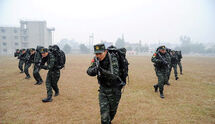
CFU Army soldiers training in Harbin.
The military of the CFU is known as the Chinese Federated Union Armed Forces. Their equipment mostly consists of left over weapons from the People's Liberation Army - including the PRC's nuclear arsenal, and new equipment purchased from foreign nations such as the United States, France, Italy, Israel, and Russia. It's branches are divided into the Army, Navy, and Air Force. The CFU Marine Corps is part of the CFU Navy. The CFU is one of the states that possesses nuclear weapons, in which its CFU Strategic Missile Forces (formerly the Second Artillery Corps of the PLAAF) is part of the CFU Air Force.
The European Union finalized the lifting of its arms embargo to the new China in 1996.
Foreign Relations
The Chinese Federated Union is a member of the United Nations Security Council after being recognized as the successor of the People's Republic. It has good relations with the United States and the West, as analysts call it a "friendly rivalry" as the two nations compete on which will have the biggest GDP and economy.
The new democratic China has better relations with Japan after the latter formally apologized to the countries it affected. The territorial dispute over the Senkaku Islands (Diayu Islands) has presented challenges of the relations of China and Japan, but relations remain cordial at best since no confrontation happened. The same could be said for CFU and the countries of the Philippines, the newly independent Taiwan, Brunei, Malaysia, and Vietnam; all of which have overlapping claims on the South China Sea. Relations remain cordial at best with these states as the CFU implores a non-aggressive policy on the matter. These nations are currently in talks on how to resolve the South China Sea and East China Sea dispute.
External Links
- Tiananmen Square - Timeline # 195: Borrows some plot elements from this timeline.
- Gate Of Heavenly Peace: This nation was inspired by the events of this mentioned timeline, along with the Chinese Civil War 1990-1996.
